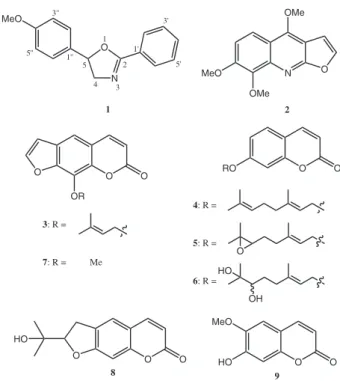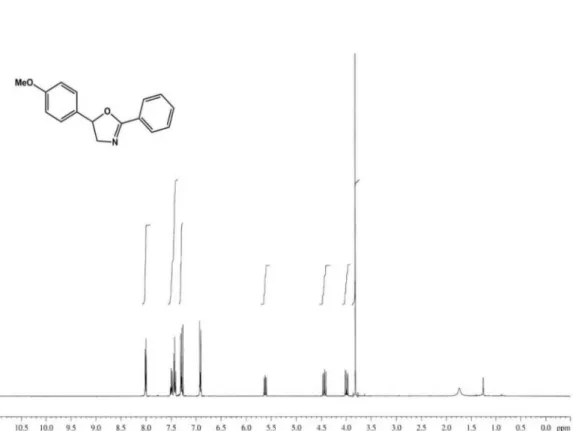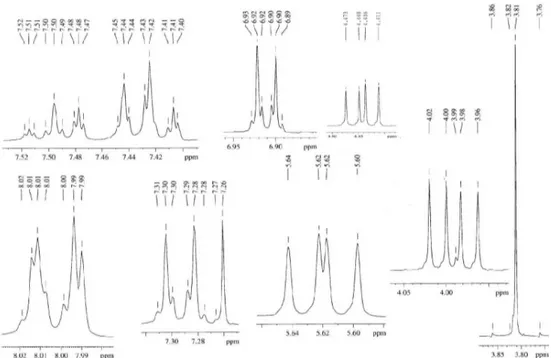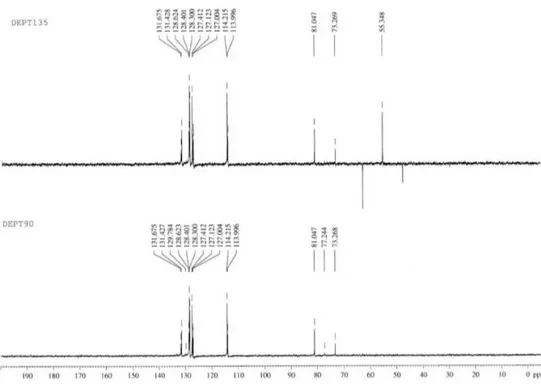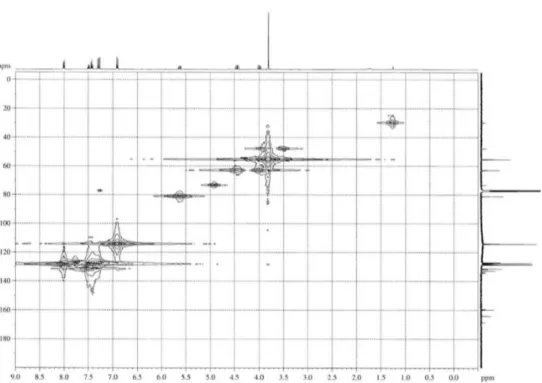Short Report
S
J. Braz. Chem. Soc., Vol. 22, No. 1, 176-178, 2011. Printed in Brazil - ©2011 Sociedade Brasileira de Química 0103 - 5053 $6.00+0.00*e-mail: surat@mfu.ac.th, suratlpk@gmail.com
Chemical Constituents from
Aegle marmelos
Surat Laphookhieo,* Chalita Phungpanya, Cholpisut Tantapakul, Somsak Techa, Suphara Tha-in and Wanwasan Narmdorkmai
Natural Products Research Laboratory, School of Science, Mae Fah Luang University, Tasud, Muang, Chiang Rai 57100, Thailand
Um novo produto natural derivado da oxazolina, chamado aeglemarmelosina (1), juntamente com oito compostos conhecidos (2-9), foi isolado a partir de raízes e ramos de Aegle marmelos. Os compostos 1-6 foram isolados das raízes e 7-9 dos galhos. Os compostos 5 e 6 também foram encontrados nos galhos. Todas as estruturas foram caracterizadas por métodos espectroscópicos de RMN uni e bidimensionais
A new natural product oxazoline derivative named aeglemarmelosine (1) along with eight known compounds (2-9) were isolated from roots and twigs of Aegle marmelos. Compounds 1-6 were isolated from the roots whereas compounds 7-9 were obtained from twigs. Compounds 5 and 6 were also detected from the twigs. All structures were characterized by extensive 1D and 2D NMR spectroscopic methods.
Keywords: Aegle marmelos, oxazoline, coumarins, alkaloids and Rutaceae
Introduction
Aegle marmelos,commonly known as “Ma Toom” in Thai, belongs to the Rutaceae family. Several parts of this plant have been used by the local Thai people in folk medicines. For example, the infusion of dried unripe fruits has been used as antidiarrhea and antidysentery agents, the juice from crushed leaves has been used for the treatment of bronchitis, and the decoction of root barks has also been used as anti-malarial drug.1 In addition, young leaves are used as vegetable. The
chemical investigation of the leaves of this plant has revealed the presence of a number of alkaloids2-7 and coumarins.1,8,9
In our continuing study on chemical constituents from Thai medicinal plants, we now report herein the isolation and structure elucidation of a rare natural product oxazoline derivative product (1) along with eight known compounds (2-9) (Figure 1) from the roots and twigs of A. marmelos.
Experimental
General procedure
UV spectra were recorded with a Perkin-Elmer UV-Vis spectrophotometer. The IR spectra were recorded
with a Perkin-Elmer FT-IR spectrophotometer. The
1Hand 13CNMR spectra were recorded using 400 MHz
Bruker FT-NMR Ultra Shield spectrometer. Chemical shifts were recorded in parts per million (d) in CDCl3
O O O OR N O OMe OMe MeO MeO N O 1 2 3 4 5 1' 3' 5' 1'' 3'' 5'' O RO O O HO OH 1 2
4: R =
5: R =
6: R =
O O MeO HO O O O HO
3: R =
7: R = Me
8 9
Laphookhieo et al. S Vol. 22, No. 1, 2011
with tetramethylsilane (TMS) as an internal reference. High resolution mass spectra were obtained using Bruker microTOF mass spectrometer. Dried flash column chromatography and column chromatography (CC) were carried out on silica gel 60 H (Merck, 5-40 μm) and silica gel 100 (Merck, 63-200 μm), respectively. Precoated plates of silica gel 60 F254 were used for analytical purposes.
Plant material
The roots and twigs of A. marmelos were collected from Chiang Rai Province, northern part of Thailand, in December 2008. Botanical identiication was achieved through comparison with a voucher specimen number QBG 33029 in the Herbarium Collection of Queen Sirikit Garden, Mae Rim District, Chiang Mai, Thailand.
Extraction and isolation
The roots (160 g) and the twigs (4.5 kg) of A. marmelos
were extracted with dichloromethane (CH2Cl2), over a period of 3 days, at room temperature, and evaporated under reduced pressure, to provide crude CH2Cl2 extracts of roots (8.40 g) and twigs (15.34 g).
The CH2Cl2 extract from the roots was chromatographed by dried lash column chromatography over silica gel and eluted with a gradient of hexane-EtOAc (10:0, 9:1, 8:2, 7:3, 6:4, 5:5, 4:6, 3:7, 2:8, 1:9, 0:10, v/v), to afford compound 2 (504 mg) and twenty-four fractions (MTC_1A-MTC_1Z). Fraction MTC_1D (48 mg) was puriied by preparative TLC with acetone-hexane (1:5, v/v) to afford compound 4 (10 mg). Compound 5
(10 mg) was derived from Fraction MTC_1G (40 mg) by preparative TLC with 100% CHCl3. Fraction MTC_1J (36 mg) was further puriied by preparative TLC with CH2Cl2-hexane (4:1, v/v) to give compounds 1 (9.7 mg) and 3 (5.7 mg). Fractions MTC_1L (1.4 g) was subjected to CC (CH2Cl2-hexane, 1:1, v/v) to give compounds 3
(50 mg) and 6 (165 mg).
The CH2Cl2 extract from the twigs was subjected to dried lash column chromatography over silica gel and eluted with a gradient of hexane-EtOAc (10:0, 9:1, 8:2, 7:3, 6:4, 5:5, 4:6, 3:7, 2:8, 1:9, 0:10, v/v), to afford ten fractions. Fraction AMD3 (631.5 mg) was repeated dried lash column chromatography with 100% CH2Cl2, to give compounds 8 (25.2 mg) and 9 (25.6 mg). Compounds 5
(5.97 mg) and 7 (8.4 mg) were derived from fraction AMD5 (1.11 g) by repeated dried lash column chromatography with CH2Cl2-hexane (3:7, v/v). Fraction AMD6 (1.37 g) was further puriied by CC with MeOH-CH2Cl2 (1:99, v/v), to yield compound 6 (79.5 mg).
Aeglemarmelosine (1)
Orange viscous oil; [α]27
D+7.89° (c 0.20, CHCl3); UV
(CHCl3) λ
max/nm: 240; IR (neat) νmax/cm
-1: 2918, 2489,
1650, 1615, 1515, 1248, 756; 1HNMR (400 MHz, CDCl 3): d 8.10 (2H, m, H-2′/H-6′), 7.48 (1H, tt, J 8.0, 2.0 Hz, H-4′),
7.42 (2H, m, H-3′/H-5′), 7.28 (2H, d, J 8.8 Hz, H-2′′/6′′),
6.91 (2H, d, J 8.8 Hz, 3′′/5′′), 5.51 (1H, dd, J 10.0, 8.0 Hz, H-5), 4.44 (1H, dd, J 14.8, 10.0 Hz, H-4a), 3.99 (1H, dd,
J 14.8, 8.0 Hz, 4b), and 3.81 (3H, s, 4′′−OMe); 13C NMR
(100 MHz, CDCl3): d 164.0 (C-2), 159.7 (C-4′′), 132.9
(C-1′′), 131.4 (C-4′), 128.6 (C-1′), 128.4 (C-2′ and C-6′),
128.3 (C-3′ and C-5′), 127.4 (C-2′′ and C-6′′), 114.2
(C-3′′ and C-5′′), 81.1 (C-5), 62.9 (C-4) and 55.3 (4′′−OMe);
HR-MS (APCI, +ve) m/z 254.1180 [M+H]+ (calc. for
C16H16NO2, 254.1181).
Antimalarial assay
Antimalarial activity was evaluated against the parasite Plasmodium falciparum (K1, mutidrug resistant), using the method of Trager and Jensen.10 Quantitative
assessment of in vitro malarial activity was determined by means of the microculture radioisotope technique based on the method described by Desjardins et al.11
The inhibitory concentration (IC50) represented the concentration that caused 50% reduction in parasite growth which was indicated by the in vitro uptake of [3H]-hypoxanthine by P. falciparum. The standard
compound was dihydroartemisinin (IC50 4.1 nmol L-1).
Results and Discussion
Aeglemarmelosine (1) [α]27
D+7.89° (c 0.20, CHCl3) was
isolated as an orange viscous oil. A molecular formula, C16H15NO2, was established by HR-MS analysis of its ion peak [M+H]+ at m/z 254.1180 (calc. for C
16H16NO2 m/z
254.1181). The 1H NMR spectral data of 1 (Table 1) showed
the characteristic of oxazoline framework2 at d5.51 (dd,
10.0, 8.0 Hz), 4.44 (dd, 14.8, 10.0 Hz) and 3.99 (dd, 14.8, 8.0 Hz) which were identiied for H-5, and H-4a and H-4b, respectively. The remaining 1H NMR spectral data could be
characterized as being due to a monosubstituted aromatic ring [d 8.10 (m, 2H, H-2′ and H-6′), 7.42 (m, H-3′ and H-5′)
and 7.48 (tt, 8.0, 2.0 Hz, H-4′)], and a 4-methoxyphenyl
group (1,4-disubstituted aromatic ring) [d 7.28 (d, 8.8 Hz, 2H, H-2′′ and H-6′′), 6.91 (d, 8.8 Hz, 2H, H-3′′ and H-5′′)
and 3.81 (s, 4′′-OMe)]. The monosubstituted aromatic
ring was connected to C-2 of the oxazoline ring because of the 2J and 3J connectivity of H-2′ (d 8.10) and H-3′ (d
Chemical Constituents from Aegle marmelos J. Braz. Chem. Soc.
178
(Figure 2), whereas the 4-methoxyphenyl group was placed on C-5 of the oxazoline ring because the H-5 (d 5.51) and H-4 (d 4.44 and 3.99) showed HMBC correlation to C-1′′ (d 132.9). The oxazoline derivative 1,therefore, was identiied as being aeglemarmelosine (2-phenyl-5-(4-methoxyphenyl)-D2-oxazoline) which has been reported as
a synthetic compound by Callens et al.12
The remaining compounds were characterized as skimmianine (2),13 imperatorin (3),14 aurapten (4),15
epoxyaurapten (5),15 marmin (6),15 xanthotoxin (7),14
marmisin (8)16 and scopoletin (9)17 by using extensive 1D
and 2D NMR spectroscopy and by comparing of their spectral data with reported values. All compounds were tested for their antimalarial activity but, unfortunately, they were inactive.
Supplementary Information
Supplementary data are available free of charge at http://jbcs.sbq.org.br, as PDF ile.
Acknowledgments
This work was supported by the Thailand Research Fund (grant number RSA5280011) and Mae Fah Luang University. We are indebted to Mr. Nitirat Chimnoi, Chulabhorn Research Institute, Bangkok, for recoding the mass spectra, and Assoc. Prof. Dr. Uma Prawat and Ms. Nareerat Thongtip, Department of Chemistry, Rajabhat Phuket University, Phuket, for recording the NMR spectra.
References
1. Mishra, B. B.; Singh, D. D.; Kishore, N.; Tiwari, V. K.; Tripathi, V. Phytochemistry2010, 71, 230.
2. Phuwapraisirisan, P.; Puksasook, T.; Jong-aramruang, J.; Kokpol, U.; Bioorg. Med. Chem. Lett.2008, 18, 4956. 3. Faizi, S.; Farooqi, F.; Zikr-Ur-Rehman, S.; Naz, A.; Noor, F.;
Ansari, F.; Ahmad A.; Khan, S. A.; Tetrahedron2009, 65, 998. 4. Manandhar, M. D.; Shoeb, A.; Kapil, R. S.; Popli, S. P.;
Phytochemistry1978, 17, 1814.
5. Basu, D.; Sen, R.; Phytochemistry1974, 13, 2329.
6. Sharma, B. R.; Rattan, R. K.; Sharma, P.; Phytochemistry1981,
20, 2606.
7. Govindachari, T. R.; Premila, M.S.; Phytochemistry1983, 22, 755.
8. Ali, M. S.; Pervez, M. K.; Nat. Prod. Res. 2004, 18, 141. 9. Ohashi, K.; Watanabe, H.; Ohi, K.; Arimoto, H.; Okumura, Y.;
Chem. Lett. 1995, 24, 881.
10. Trager, W.; Jensen, J. B.; Science1976, 193, 673.
11. Desjardins, R. E.; Canield, C. J.; Haynes, J. D.; Chulay, J. D.;
Antimicrob. Agents Chemother.1979, 16, 710.
12. Callens, R.; Anteunis, M. J. O.; De Witte, M.;Bull. Soc. Chim. Belg. 1987, 96, 619.
13. Inada, A.; Ogasawara, R.; Koga, I.; Nakatami, N.; Inatomi, Y.; Murata, H.; Nishi, M.; Naganishi, T.; Chem. Pharm. Bull.2008,
56, 727.
14. Masuda, T.; Takasugi, M.; Anetai, M.; Phytochemistry1998,
47, 13.
15. Chen, I. S.; Lin, Y. C.; Tsai, I. L.; Teng, C. M.; Ko, F. N.; Ishikawa, T.; Ishii, H.; Phytochemistry1995, 39, 1091. 16. Rondest, J.; Das, B. C.; Ricroch, M. N.; Kan-Fan, C.; Potier,
P.; Polonsky, J.; Phytochemistry1968, 7, 1019.
17. Cassady, J. M.; Ojima, N.; Chang, C. J.; McLaughlin, J. L.;
J. Nat. Prod. 1979,42, 274.
Submitted: January 4, 2010
Published online: August 10, 2010
Supplementary Information
J. Braz. Chem. Soc., Vol. 22, No. 1, S1-S8, 2011. Printed in Brazil - ©2011 Sociedade Brasileira de Química
0103 - 5053 $6.00+0.00
S
I
*e-mail: surat@mfu.ac.th, suratlpk@gmail.com
Chemical Constituents from
Aegle marmelos
Surat Laphookhieo,* Chalita Phungpanya, Cholpisut Tantapakul, Somsak Techa, Suphara Tha-in and Wanwasan Narmdorkmai
Natural Products Research Laboratory, School of Science, Mae Fah Luang University, Tasud, Muang, Chiang Rai 57100, Thailand
Chemical Constituents from Aegle marmelos J. Braz. Chem. Soc.
S2
Figure S3. 13C NMR spectrum of 1 (100 MHz, CDCl 3).
Laphookhieo et al. S3 Vol. 22, No. 1, 2011
Figure S5. COSY spectrum of 1.
Chemical Constituents from Aegle marmelos J. Braz. Chem. Soc.
S4
Figure S7. HMBC spectrum of 1.
Laphookhieo et al. S5 Vol. 22, No. 1, 2011
Figure S9.1H NMR spectrum of 3 (400 MHz, CDCl 3).
Chemical Constituents from Aegle marmelos J. Braz. Chem. Soc.
S6
Figure S11.1H NMR spectrum of 5 (400 MHz, CDCl 3).
Laphookhieo et al. S7 Vol. 22, No. 1, 2011
Figure S13.1H NMR spectrum of 7 (400 MHz, CDCl 3).
Chemical Constituents from Aegle marmelos J. Braz. Chem. Soc.
S8
Figure S14.1H NMR spectrum of 8 (400 MHz, CDCl 3).
